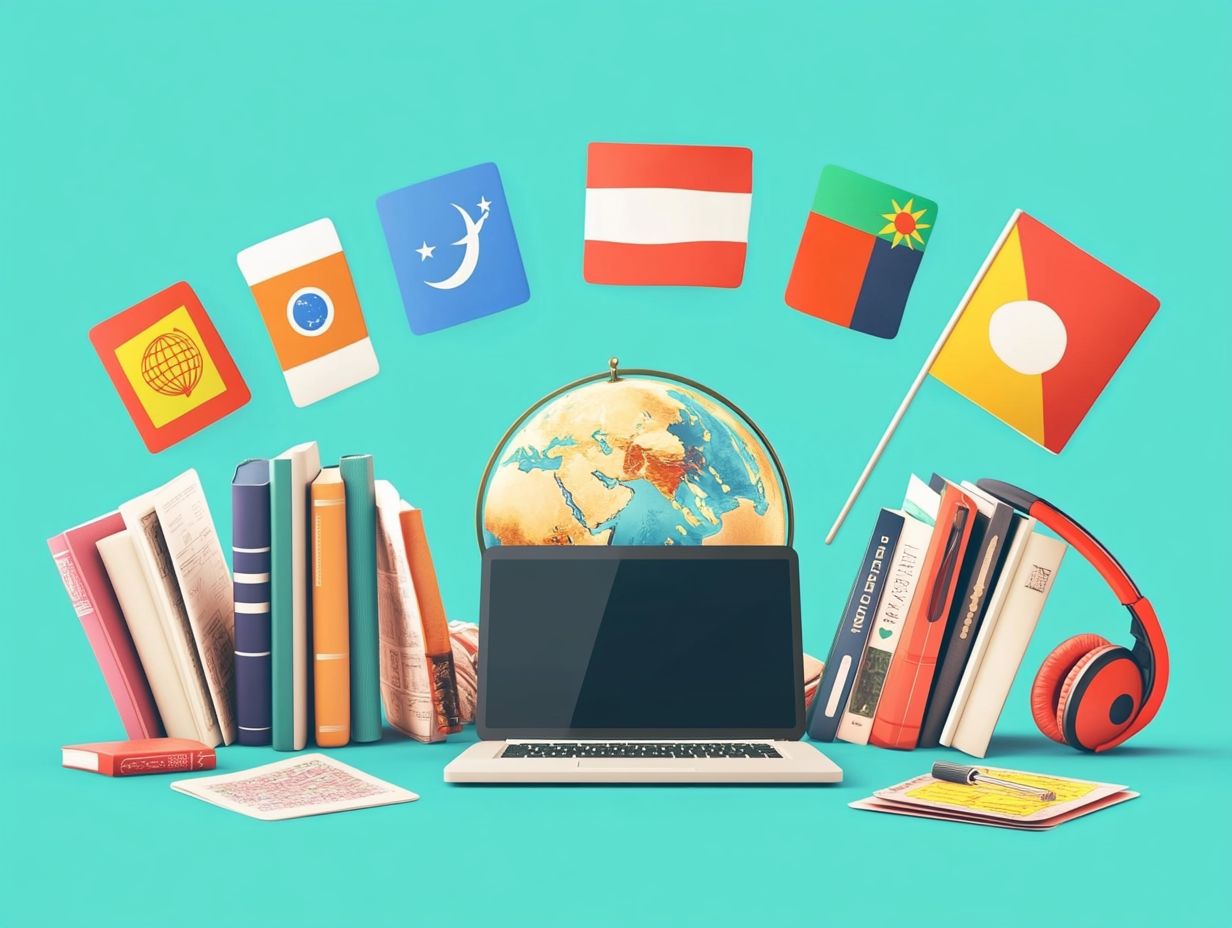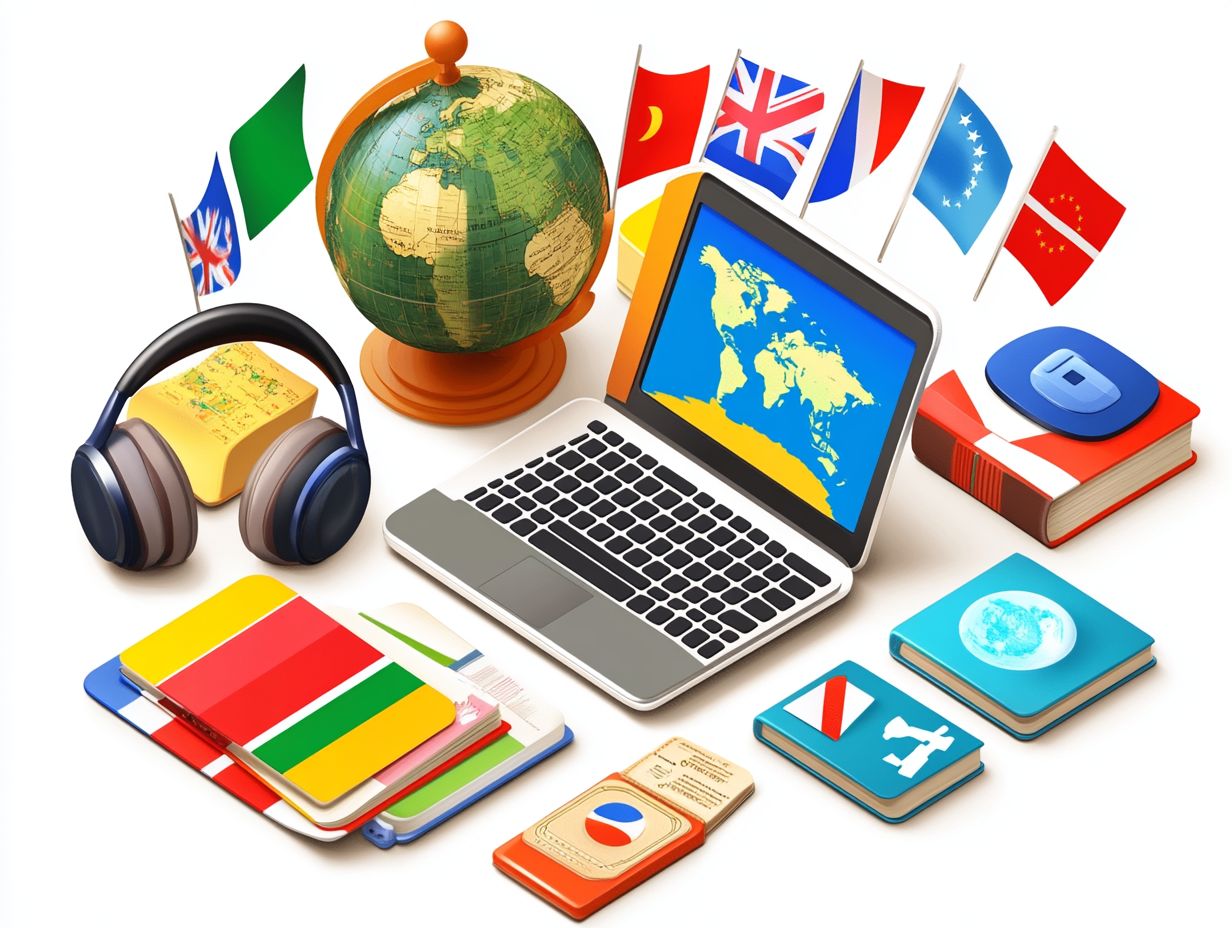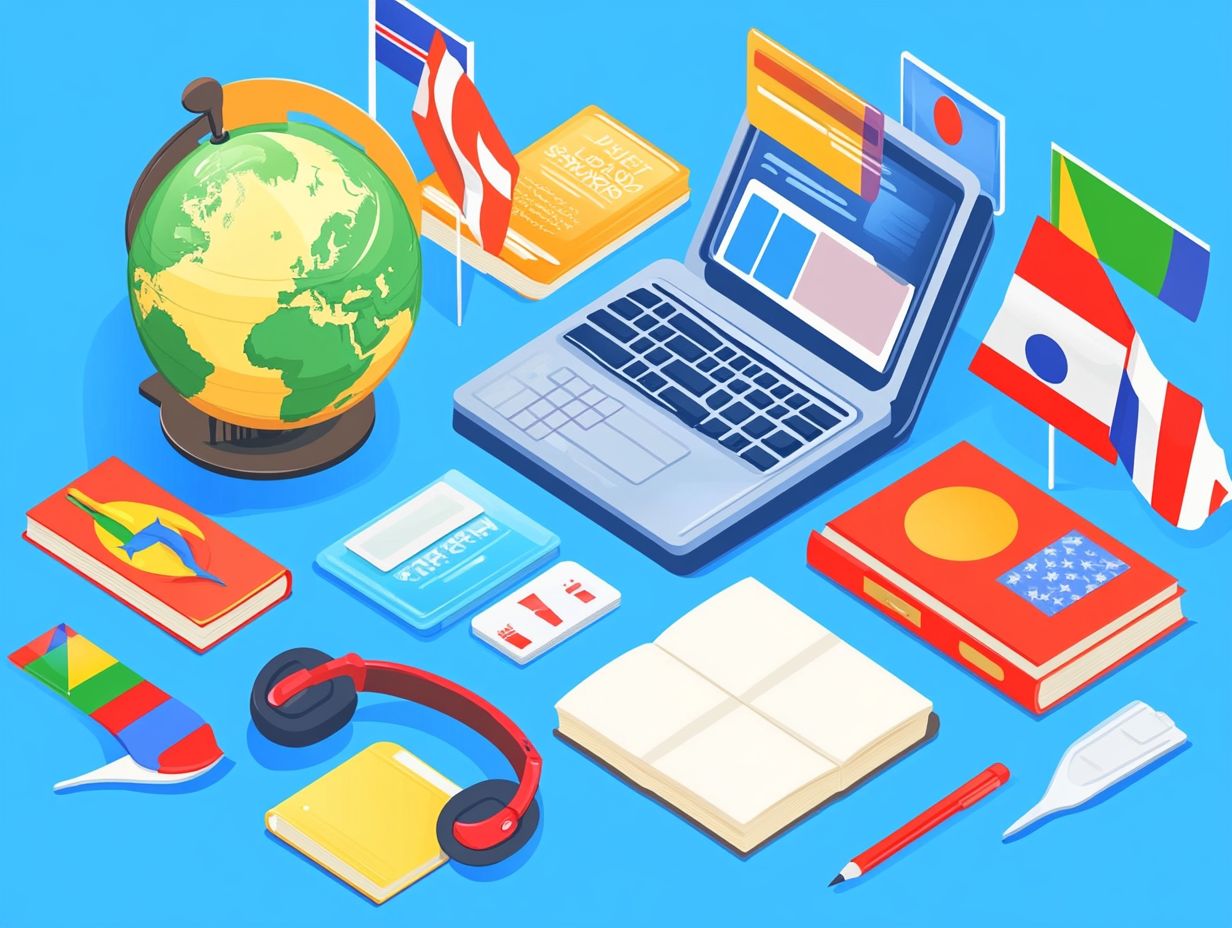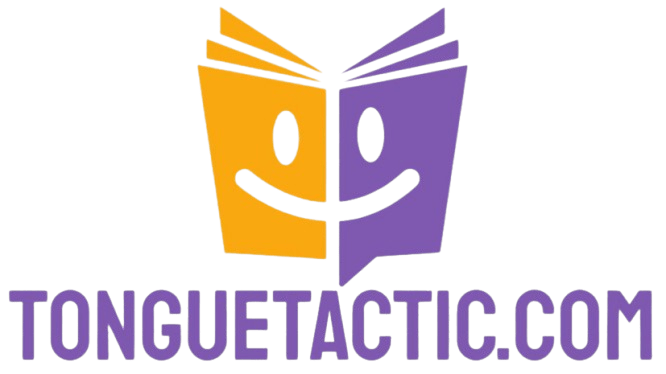10 must-have resources for language immersion
Get ready to dive into an exciting journey of language learning! With an array of tools at your disposal, starting your adventure has never been easier. Knowing where to begin is crucial for effective learning.
This article lays out ten essential tools, spanning language learning apps, online courses, podcasts, and community exchanges. All are designed to provide you with a well-rounded approach.
By delving into these diverse resources and mastering how to use them effectively, you ll find yourself better prepared to overcome language barriers and elevate your fluency.
Jump in to discover amazing strategies that can supercharge your language learning!
Contents
- Key Takeaways:
- 1. Language Learning Apps
- 2. Online Language Courses
- 3. Language Exchange Programs
- 4. Language Learning Websites
- 5. Language Learning Communities
- 6. Language Learning Books and Textbooks
- 7. Language Learning Podcasts
- 8. Language Learning Videos and Movies
- 9. Language Learning Games and Activities
- 10. Language Learning Classes or Tutors
- How to Choose the Right Resources for Your Language Immersion Journey?
- What Are the Different Types of Language Learning Resources?
- How Can Language Immersion Resources Enhance Language Learning?
- What Are the Benefits of Using a Variety of Resources for Language Immersion?
- How Can Language Immersion Resources Be Used Effectively?
- What Are the Common Challenges When Using Language Immersion Resources?
- Frequently Asked Questions
- What are the 10 must-have resources for language immersion?
- Why are these resources considered must-haves for language immersion?
- How can language learning software or apps contribute to language immersion?
- What role do conversation partners or language exchange programs play in language immersion?
- How do cultural immersion experiences contribute to language immersion?
- Are there any other resources that can be helpful for language immersion?
Key Takeaways:

Language immersion is a powerful way to learn a new language, and there are many essential tools for language learning available to support this journey.
Some essential resources include apps, online courses, language exchange programs, and 5 interactive language immersion experiences for community support.
Using the right combination of these resources can greatly enhance your language learning experience, especially if you consider exploring the top 10 cities for language immersion experiences.
1. Language Learning Apps
Language learning apps have transformed the way you and your child engage with learning two languages. They offer invaluable tools that support literacy development and effectively bridge the language gap for both native Spanish speakers and English learners.
These digital resources do more than just teach vocabulary. They enrich reading comprehension and immerse you in captivating cultural content.
For example, Capstone provides interactive eBooks that captivate students with engaging stories in both languages. This also nurtures an appreciation for diverse narratives.
Meanwhile, PebbleGo offers research-based articles that spark curiosity across a range of subjects. This enhances literacy skills while deepening cultural understanding.
By integrating these apps into the curriculum, educators enable you and your child to navigate the bilingual landscape with confidence. This approach builds fluency and critical thinking skills, which are vital for success in school.
2. Online Language Courses
Online language courses present you with flexible learning opportunities that cater to both students and teachers in dual immersion settings. These courses equip you with essential literacy education tools to foster language acquisition and support dual language learners (DLLs).
You ll find these courses in a variety of formats, including synchronous and asynchronous options. This allows you to engage at your own pace or in real-time with instructors and peers.
Webinars, interactive videos, and self-paced modules are key components designed to enhance curriculum delivery.
Many platforms also feature resources like discussion forums and collaborative projects. This gives educators the chance to share best practices and learn from one another.
This robust selection of offerings ensures that you, whether as a student or educator, can effectively develop your skills and knowledge. Tailor your educational experiences to meet the unique demands of dual immersion classrooms.
3. Language Exchange Programs
Language exchange programs offer you an immersive experience that allows for meaningful interactions. This enhances your bilingual skills and deepens your appreciation for cultural traditions through direct communication with native speakers.
In these programs, you ll find a dynamic environment where you can practice your language skills in real time. This significantly boosts your metalinguistic awareness, meaning being aware of how languages work, which helps you learn more effectively.
As you navigate various languages and dialects, you’ll refine your communication abilities and uncover the rich nuances of the cultures you’re exploring.
The inquiry cycle is crucial in this journey. It invites you to ask questions, reflect on your learning experiences, and adjust your strategies based on feedback.
This iterative process fosters a deeper understanding and competency, ultimately enriching your entire language learning adventure.
4. Language Learning Websites
Language learning websites are invaluable resources for students and educators. They offer a wealth of materials to enhance literacy skills and vocabulary instruction. These sites also provide effective assessment tools that align with dual-language immersion curricula.
These platforms come packed with diverse features. They include interactive quizzes that elevate engagement and educational apps tailored to various learning styles. Such tools allow you to practice reading in an enjoyable and dynamic way, significantly improving your reading comprehension.
The accessibility of these resources makes them perfect for fostering literacy among dual language learners (DLLs). By incorporating multimedia elements and customized content, these websites not only help you grasp the intricacies of language but also ignite a passion for reading. This ensures that every student can flourish in a supportive and enriching environment.
5. Language Learning Communities
Language learning communities, including professional learning communities (PLCs), encourage collaboration and support among educators and parents. This dynamic enhances outreach to local parents and fosters meaningful discussions about students’ progress in literacy development.
These communities take many forms, such as online forums, workshop groups, and in-person meetups. Each offers unique chances for educators to collaborate, share resources, and engage in professional development. Social media networks facilitate these connections, helping members exchange best practices and celebrate successes in real-time.
To engage local parents in these communities, consider strategies such as:
- Hosting informational workshops
- Using social media to share updates
- Creating inclusive events
These approaches can help families actively participate in their children s language learning journey. Get involved today and witness your child s language journey thrive!
6. Language Learning Books and Textbooks

Language learning books and textbooks are essential components of dual-language immersion programs. They offer curriculum-aligned materials that support speaking and reading in two languages while enhancing literacy education for students at various reading levels.
These resources come in various formats, from beautifully illustrated storybooks to detailed workbooks designed to meet diverse learning needs. You can easily integrate these materials into your lesson plans, using them for reading practice and to cultivate cultural awareness among your students.
By crafting engaging activities that promote interactive reading and discussion, you can help your students draw connections between languages. This ultimately enriches their overall educational journey.
Choosing age-appropriate and culturally relevant texts will motivate learners and create a dynamic and enjoyable learning environment while fostering essential literacy skills.
7. Language Learning Podcasts
Language learning podcasts are exciting gateways into the world of language! They offer opportunities for students and educators to engage with language in relatable contexts.
These audio resources enhance your listening skills and weave a rich tapestry of cultural insights. They deepen your understanding and appreciation of diverse backgrounds. Popular podcasts delve into themes like local customs, idiomatic expressions, and historical events, helping you connect language with real-world experiences.
In educational settings, you can easily integrate these resources into your curriculum. They spark dialogues that celebrate heritage while reinforcing language skills. These podcasts also help improve your professional skills, allowing you to refine your teaching methods and embrace cultural nuances that enrich the learning environment.
8. Language Learning Videos and Movies
Language learning videos and movies offer immersive experiences that captivate your attention, enhance your bilingual skills, and effectively convey cultural traditions. These resources are invaluable in bilingual classes.
These instructional videos do more than just introduce vocabulary and grammatical structures; they create contexts that encourage meaningful conversations among peers. By showcasing characters and scenarios from diverse backgrounds, the content ensures that you see yourself represented, boosting your motivation and promoting active participation.
You can leverage these resources to customize lessons that resonate with your personal experiences, fostering a deeper connection to the material. This culturally relevant approach enhances your literacy skills by contextualizing language use, ultimately enriching your overall learning journey.
9. Language Learning Games and Activities
Language learning games and activities invite you to immerse yourself in interactive experiences, making reading practice feel less like a chore and more like an engaging adventure.
These methods enhance your vocabulary and deepen your understanding of texts, all while seamlessly fitting into bilingual curricula.
Imagine diving into word puzzles, interactive storytelling, and role-playing activities that can be effortlessly woven into lesson plans to create an engaging atmosphere.
Incorporating gamified elements can skyrocket your motivation and make learning new words a breeze! Embracing these techniques allows educators to cultivate a vibrant classroom environment, encouraging your participation and transforming language acquisition into something truly enjoyable and impactful.
10. Language Learning Classes or Tutors
Language learning classes or private tutors offer personalized instruction that can significantly boost your language acquisition process while also supporting educators in their professional development and effectiveness in teaching English.
These instructional formats, whether through one-on-one tutoring or engaging group sessions, create adaptable learning environments tailored to your needs.
One-on-one tutoring provides focused attention, allowing you to progress at your own pace. Meanwhile, group sessions encourage collaboration and mutual support among peers.
Both approaches are essential in assisting dual language learners as they navigate the complexities of language acquisition. By integrating diverse teaching strategies and real-world applications, educators can better address the varying challenges you encounter, ultimately leading to a more enriching educational experience for everyone involved.
How to Choose the Right Resources for Your Language Immersion Journey?
Choosing the right resources for your language immersion journey is essential for cultivating a bilingual vision. Utilizing 7 tips for language immersion at home helps educators and students benefit from effective professional learning communities (PLCs) and engaging language interactions.
As you embark on this pursuit, it s vital to evaluate resources that align with the curriculum and resonate with various learning styles and cultural contexts. Consider the adaptability of the materials, their relevance to your specific educational goals, and how effectively they facilitate communication among students.
Engaging the local community by involving parents can significantly bolster support for the program. Their participation enriches the learning environment, fostering a more inclusive atmosphere.
Working with families creates a consistent language experience that enriches learning, reinforcing the immersion process beyond the school walls.
What Are the Different Types of Language Learning Resources?

Language learning resources include many tools like apps, books, online courses, and community programs. For those pursuing dual language immersion, following 5 essential tips for language immersion success is crucial for improving your language skills.
Each resource offers unique advantages suited to different learning environments. For instance, interactive apps provide personalized learning experiences, engaging you with gamified lessons that adapt to your individual progress.
Traditional books encourage deep reading and comprehension, nurturing critical thinking abilities. Online courses offer flexibility and accessibility, making them perfect for educators connecting with diverse student populations.
Community programs emphasize immersive experiences, allowing you to practice language skills in real-world settings.
Together, these resources create a comprehensive literacy ecosystem that supports you at every stage of your educational journey.
How Can Language Immersion Resources Enhance Language Learning?
Language immersion resources can supercharge your learning experience! They provide various opportunities for acquisition, boost reading comprehension, and support dual language learners, often called DLLs, across different educational settings. Exploring 5 effective language immersion techniques can further enhance your journey.
These resources typically feature multimedia tools, interactive activities, and culturally relevant materials that engage you more effectively. When educators use these resources and participate in professional development, they can implement teaching methods tailored to their classrooms.
Student engagement skyrockets when you use these resources, leading to vibrant learning experiences where you actively participate and apply your language skills. This immersive approach builds confidence and nurtures a deeper appreciation for the cultural nuances of the language you are studying.
What Are the Benefits of Using a Variety of Resources for Language Immersion?
Using a rich array of resources for language immersion offers numerous benefits. You’ll enhance your literacy, gain a deeper understanding of cultural traditions, and experience improved engagement through 5 immersive activities for language learners tailored to your learning needs.
By exploring various mediums like podcasts, videos, books, and interactive activities, you can discover which resources resonate best with your unique style. This approach nurtures your reading and writing skills and fosters listening and speaking fluency, helping you achieve a well-rounded grasp of the language.
Diversity in materials keeps motivation soaring! You re more likely to enjoy learning when it includes captivating elements, from music to games.
This holistic approach ensures that language acquisition becomes an enriching journey rather than a mechanical exercise, respecting your preferences and igniting your intellectual curiosity.
How Can Language Immersion Resources Be Used Effectively?
To effectively utilize language immersion resources, implement tailored instructional methods, use scaffolding strategies, and consistently employ assessment tools that measure progress and optimize learning outcomes.
To elevate effectiveness, integrate authentic materials that resonate with your students interests and connect to real-world contexts.
Incorporating technology like language learning apps and online resources can enrich the immersion experience, making it more engaging with fun language games for immersion learning.
Creating a supportive environment that encourages risk-taking and open communication is vital. Regular feedback sessions allow learners to discuss challenges and successes, providing valuable insights into their progress.
Continuously reflect on the effectiveness of these resources, making adjustments as needed to address evolving classroom dynamics and individual student needs.
What Are the Common Challenges When Using Language Immersion Resources?
Using language immersion resources can be challenging. You may struggle to balance bilingual and biliteracy goals, integrate instructional videos, and meet diverse classroom needs.
Limited access to quality materials often hinders educators. This can seriously affect immersion program effectiveness and student proficiency.
Your school should invest in curated resource collections. This will help you incorporate them seamlessly into lesson plans.
Encouraging collaboration among educators fosters the sharing of best practices and valuable tools.
Tailored training sessions can boost your confidence. This enhances student engagement and overall outcomes.
Frequently Asked Questions
What are the 10 must-have resources for language immersion?

The 10 must-have resources for language immersion include:
- Language learning software or apps
- Audio and video content in the target language
- Online language courses
- Conversation partners or language exchange programs
- Flashcards for vocabulary
- Grammar books or reference materials
- Language learning podcasts
- Cultural immersion experiences, like travel or studying abroad
- Online dictionaries or translation tools
- Language learning communities or forums
Why are these resources considered must-haves for language immersion?
These resources are essential because they provide a comprehensive approach to language learning. They combine interactive, visual, auditory, and social experiences, including 5 immersive language learning resources you need, which are crucial for effective language immersion.
How can language learning software or apps contribute to language immersion?
Language learning software and apps offer structured, interactive experiences. They include games, quizzes, and progress tracking while providing a variety of learning resources like vocabulary lists and grammar exercises.
What role do conversation partners or language exchange programs play in language immersion?
Conversation partners allow learners to practice speaking and listening with native speakers. This interaction enhances conversational skills, pronunciation, and cultural insights.
How do cultural immersion experiences contribute to language immersion?
Cultural immersion experiences, such as travel or studying abroad, offer learners a way to fully engage with the language and culture. Living among native speakers improves language skills and deepens cultural appreciation.
Are there any other resources that can be helpful for language immersion?
Yes, other helpful resources include language learning books, online tutors, and local language clubs. The best tools depend on individual learning styles and needs.






